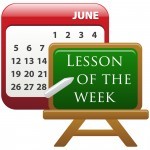Lesson of the Week: Ben Skowronski- Proper Sequence and Lag
By Wayne | Videos: Lesson of the Week

This is my 3rd lesson with Ben, and as you will see, he is really a problem case. This is where a teacher really must know what he or she is doing to get this guy to actually compress the golf ball. Luckily, Ben’s backswing has no serious flaws, although I would like him to load deeper into his right hip and cock his wrists a bit more. This is nitpicking, however, and there are much greater priorities than perfecting his backswing. Ben has no sense of athletic sequence when it comes to the golf swing, while he can throw a ball sidearm with good form. Ben literally must build a totally new perception of the downswing and the strike of the ball if he is ever going to be able to tap into his innate athletic ability. I always start these projects with less than full shots, either a punch shot or a pitch shot, as it is much more likely that a player can feel the delay of the upper body and the club in a shorter swing. The idea is to get the hands in front of the ball at impact, and I could put a guy like Ben in a perfect approach position, ask him if he could hit it from there, and he would say “no”. The clubhead is moving so much faster than the hands at the bottom of the swing that if you have never hit a ball with forward shaft lean you just can’t figure out how the club would ever reach the ball, much less close to square, when your hands are even with the ball and the shaft is parallel to the ground. In this lesson we achieved success with the pivot sequence. Now we must deal with how the hands accept the weight of the clubhead and bend back instead of pushing the club forward.
Continue reading
